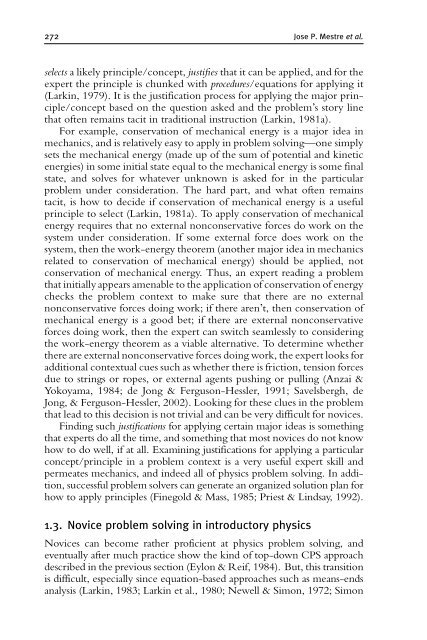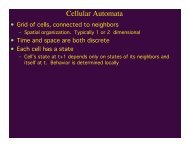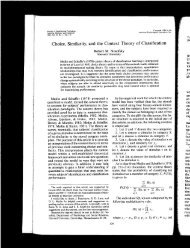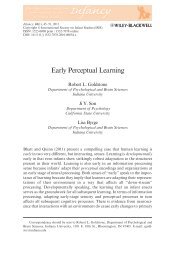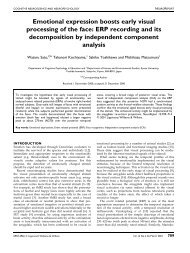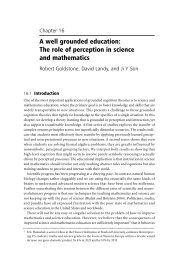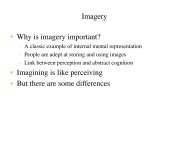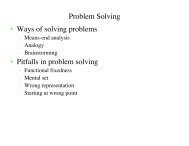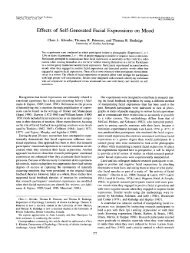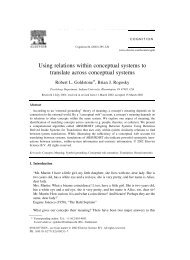the psychology of learning and motivation - Percepts and Concepts ...
the psychology of learning and motivation - Percepts and Concepts ...
the psychology of learning and motivation - Percepts and Concepts ...
Create successful ePaper yourself
Turn your PDF publications into a flip-book with our unique Google optimized e-Paper software.
272 Jose P. Mestre et al.selects a likely principle/concept, justi¢es that it can be applied, <strong>and</strong> for <strong>the</strong>expert <strong>the</strong> principle is chunked with procedures/equations for applying it(Larkin, 1979). It is <strong>the</strong> justification process for applying <strong>the</strong> major principle/conceptbased on <strong>the</strong> question asked <strong>and</strong> <strong>the</strong> problem’s story linethat <strong>of</strong>ten remains tacit in traditional instruction (Larkin, 1981a).For example, conservation <strong>of</strong> mechanical energy is a major idea inmechanics, <strong>and</strong> is relatively easy to apply in problem solving—one simplysets <strong>the</strong> mechanical energy (made up <strong>of</strong> <strong>the</strong> sum <strong>of</strong> potential <strong>and</strong> kineticenergies) in some initial state equal to <strong>the</strong> mechanical energy is some finalstate, <strong>and</strong> solves for whatever unknown is asked for in <strong>the</strong> particularproblem under consideration. The hard part, <strong>and</strong> what <strong>of</strong>ten remainstacit, is how to decide if conservation <strong>of</strong> mechanical energy is a usefulprinciple to select (Larkin, 1981a). To apply conservation <strong>of</strong> mechanicalenergy requires that no external nonconservative forces do work on <strong>the</strong>system under consideration. If some external force does work on <strong>the</strong>system, <strong>the</strong>n <strong>the</strong> work-energy <strong>the</strong>orem (ano<strong>the</strong>r major idea in mechanicsrelated to conservation <strong>of</strong> mechanical energy) should be applied, notconservation <strong>of</strong> mechanical energy. Thus, an expert reading a problemthat initially appears amenable to <strong>the</strong> application <strong>of</strong> conservation <strong>of</strong> energychecks <strong>the</strong> problem context to make sure that <strong>the</strong>re are no externalnonconservative forces doing work; if <strong>the</strong>re aren’t, <strong>the</strong>n conservation <strong>of</strong>mechanical energy is a good bet; if <strong>the</strong>re are external nonconservativeforces doing work, <strong>the</strong>n <strong>the</strong> expert can switch seamlessly to considering<strong>the</strong> work-energy <strong>the</strong>orem as a viable alternative. To determine whe<strong>the</strong>r<strong>the</strong>re are external nonconservative forces doing work, <strong>the</strong> expert looks foradditional contextual cues such as whe<strong>the</strong>r <strong>the</strong>re is friction, tension forcesdue to strings or ropes, or external agents pushing or pulling (Anzai &Yokoyama, 1984; de Jong & Ferguson-Hessler, 1991; Savelsbergh, deJong, & Ferguson-Hessler, 2002). Looking for <strong>the</strong>se clues in <strong>the</strong> problemthat lead to this decision is not trivial <strong>and</strong> can be very difficult for novices.Finding such justi¢cations for applying certain major ideas is somethingthat experts do all <strong>the</strong> time, <strong>and</strong> something that most novices do not knowhow to do well, if at all. Examining justifications for applying a particularconcept/principle in a problem context is a very useful expert skill <strong>and</strong>permeates mechanics, <strong>and</strong> indeed all <strong>of</strong> physics problem solving. In addition,successful problem solvers can generate an organized solution plan forhow to apply principles (Finegold & Mass, 1985; Priest & Lindsay, 1992).1.3. Novice problem solving in introductory physicsNovices can become ra<strong>the</strong>r pr<strong>of</strong>icient at physics problem solving, <strong>and</strong>eventually after much practice show <strong>the</strong> kind <strong>of</strong> top-down CPS approachdescribed in <strong>the</strong> previous section (Eylon & Reif, 1984). But, this transitionis difficult, especially since equation-based approaches such as means-endsanalysis (Larkin, 1983; Larkin et al., 1980; Newell & Simon, 1972; Simon


